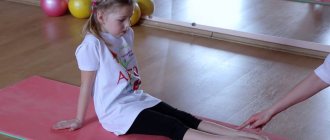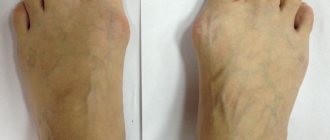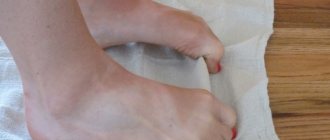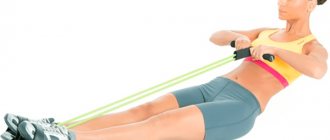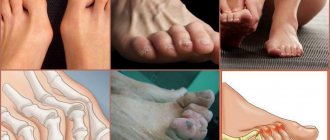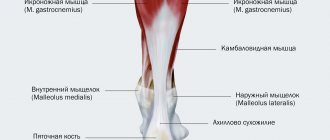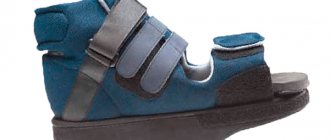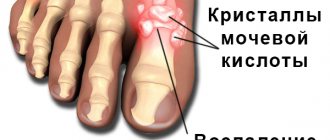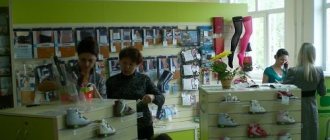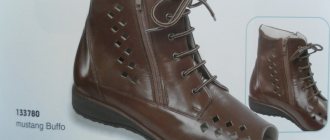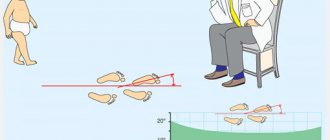Dear Doctor.
The well-known practicing doctor Komarovsky recommends that parents seek medical help at the first signs of hallux valgus in children. This defect is characterized by a decrease in the height of its arch and an X-shaped curvature of the axis. The baby's toes and heel turn outward, and the middle part drops slightly. The child's gait becomes clumsy, he complains of pain, and quickly gets tired during even a short walk.
The appearance of one of the symptoms should be an incentive to visit a pediatric orthopedist. The doctor will conduct an external examination of the child and prescribe a number of instrumental studies - x-ray of the foot, plantography, podometry. Hallux valgus deformity of mild severity responds well to treatment with conservative methods. Massage and physiotherapeutic measures are indicated, and the wearing of orthopedic devices is recommended. In severe cases of pathology, surgical correction of the feet is performed.
External manifestation.
Dr. Komarovsky about hallux valgus
Orthopedic pathology, hallux valgus, is usually detected at the age of 10–12 months, when the child stands confidently on his feet and tries to walk. The violation raises natural concerns and questions for parents.
Dr. E.O. Komarovsky urges moms and dads not to panic. The fact is that a person’s foot is fully formed at the age of 12. Therefore, the doctor believes that the problem can be corrected before this date. To do this, parents must be patient and follow the doctor's orders.
What it is?
A flatfoot in a child combines two types of changes that support and enhance each other.
Flat feet - a newborn has a physiological flat foot. This anatomical feature is explained by the soft structure of the cartilaginous surfaces of the joints, increased elasticity of the ligaments, and poor development of the leg muscles.
As a result, the foot has a low arch; the baby rests in a vertical position on the entire sole.
Important: according to statistics, flat feet are detected immediately after birth in 3% of children, at 2-4 years old - in 25-32%, before school - in 40%, and at 12 years old - in half of adolescents.
If the development of the child’s musculoskeletal system goes correctly, the strength and endurance of muscles and ligaments increases, then flat feet can be eliminated on their own. The persistence of disturbed growth conditions leads over the years to a decrease in the shock-absorbing function of the foot. The load on the knee and hip joints increases, and the spine becomes deformed.
With hallux valgus, the child rests on the inner zone of the sole. The main load falls on the big toe, the first metatarsal bone and the joint between them. The axis of the lower extremities becomes not vertical, but X-shaped and curved.
The remaining toes and heel turn outward. In advanced cases, the bases of the thumbs protrude towards the center line of the body. When straightening and bringing the legs together, a distance of more than 4 cm is determined between the ankles. The baby takes steps with difficulty, is uncertain, and gets tired quickly.
The combination with a low arch of the foot determines the essence of planovalgus deformity.
Causes of the disease
Valgus in children starting to walk, together with flat feet, is the most frequently detected orthopedic pathology in pediatrics.
Curvature can be congenital or acquired.
Congenital - occurs in the womb; it is not yet possible to accurately determine the cause. Pediatricians point out:
- large fruit;
- incorrect position;
- infections suffered by the expectant mother;
- poor nutrition of a pregnant woman;
- heredity.
It is detected in a newborn in the first 2–3 months during the next preventive examination. Usually it is not possible to cope with conservative treatment, children have to be operated on.
Acquired - formed due to impaired development of the bone structure of the limbs, ligaments, weakness of muscles and tendons. Signs become apparent around 12 months, when children begin to walk.
How to fix – treatment of X-shaped legs
Conservative treatment of X-shaped legs is carried out in cases where the patient does not have pronounced deformation processes in the area of bone tissue. The presence of bone calluses and growths is an indication for surgery for correction.
Before you can correct X-shaped legs, it is necessary to eliminate the potential cause of this pathology. To correct the condition itself, the orthopedist develops an individual course. It depends on the general condition of the patient, the presence of complications and concomitant pathologies.
In our manual therapy clinic, the following types of therapeutic effects can be used to correct X-shaped legs:
- osteopathy – allows you to normalize the processes of trophism and microcirculation of blood and lymphatic fluid;
- massage – relieves excess muscle tone and corrects muscle performance;
- Therapeutic gymnastics and kinesiotherapy are aimed at the complex harmonious development of the muscular frame of the lower extremities, due to which natural correction of leg positioning will occur;
- laser exposure is required in advanced stages.
Reflexology, physiotherapy and much more can also be used. The course of correction is developed by an orthopedist individually for each patient. If you have a similar problem, we recommend that you make an appointment right now for a free appointment with an orthopedist at our manual therapy clinic in Moscow.
Possible consequences of hallux valgus in children
It is much easier to stop the process of foot deformation in a child if treatment is started early. According to reviews of pediatric orthopedists, the most favorable prognosis for valgus curvature of the feet and legs is if the baby begins treatment at the age of about one year. There is a high probability of getting rid of the problem forever.
With late detection and lack of specialized medical care, spinal diseases develop by adolescence. Lost time reduces the chances of recovery.
Severe deformation threatens the child with disability. Increased compensatory load on the knee and hip joints deforms them and irreversibly destroys the articular surfaces. This leads to lack of motor activity, the development of arthrosis-arthritis, and stiffness.
Physiotherapy: electrophoresis with calcium
Electrophoresis is a popular procedure, which is indicated for paralysis, diseases of the upper respiratory tract, muscle dystrophy, neuritis, orthopedic problems, myositis, and hip dysplasia. During the procedure, electrodes are attached to a certain area. A paper or fabric pad soaked in a calcium solution is first placed under them. In medical institutions, impregnation is usually done with a 0.9% calcium chloride solution. The cost of physiotherapy depends on the duration of the course and the cost of the medications used.
Stages of disease development
In the development of hallux valgus in children, 4 stages are distinguished depending on the magnitude of the deviation angle and the possibilities of therapy; they can be judged from the table.
| Indicators | I degree | II degree | III degree | IV degree |
| Deflection angle in degrees | Up to 15 | 15–20 | 20–30 | More than 30 |
| Type of treatment | Conservative methods provide complete recovery. | Treatment is successful when using an integrated approach. | The correction is complex, therapeutic techniques and surgery are used, the treatment is long-term. | Surgery and a long rehabilitation process are required. |
The need for surgery
How to correct “X” legs in a child? According to Komarovsky, surgical intervention for this pathology is very rarely required (in approximately 7% of cases). Usually surgery is resorted to in severe cases. The method of correction is determined individually. The severity of the pathology and features are taken into account. At the moment, the most widely used methods are muscle transplantation to the inner edge of the foot, lengthening of the Achilles tendon, and the application of an external fixation device for permanent wear.
Surgery to correct leg deformities in children (the “X” in the photo below is just one form of deformity that requires correction) is a complex bone reconstruction that involves intervention on several bones. You can walk with full weight on your leg only in the third week after surgery. Typically, treatment is considered completed in the sixth week after surgery, when the little patient can return to his normal lifestyle. In general, the recovery period takes two or three months.
Treatment of hallux valgus in a child
Treatment goals for hallux valgus:
- strengthening the ligamentous apparatus;
- development of muscle strength in the foot;
- formation of the optimal height and curvature of the arch to perform the shock-absorbing function.
Conservative methods are used:
- foot baths;
- massage;
- physical therapy;
- swimming;
- methods of physiotherapy (magnetic therapy, laser, electrophoresis);
- wearing special corrective shoes with arch supports.
In cases of congenital pathology, rigid fixation (immobilization) of the feet with a plaster cast is used against the background of physical therapy and stimulation of muscle tone. Lack of effect requires surgical intervention.
Massage
The massage technique for planovalgus deformity is selected depending on the age and degree of curvature of the feet. The masseur successively strokes, kneads, pats, pinches, rubs:
- lumbosacral spine;
- back of the thighs, legs;
- feet.
Then the baby is turned over on his back and the large joints, ankles, and outer surface of the foot are “worked out.”
It is important to begin the massage with a reflex effect on the exit points of the nerve roots from the spinal cord. It is through them that signals go to the muscles of the feet and blood vessels. Improves nutrition and tone.
The child should experience pleasant emotions. Painful and irritating actions are prohibited. To the parents of E.O. Komarovsky recommends mastering massage techniques and performing it yourself at home every day.
Light gymnastics
Parents should take into account that the child gets bored of studying for a long time and repeating the exercises. Therefore, it is recommended to divide the entire complex into 3 parts, including 3-4 exercises, and perform them throughout the day.
Dr. Komarovsky advises practicing at home, on the grass, small pebbles, barefoot. Light exercises you can choose from:
- walking along a narrow path (low log);
- alternate walking with emphasis on the inner and outer parts of the foot and heels;
- jumping on toes;
- walking on ribbed mats;
- while sitting or standing, picking up small objects with your toes.
More complex exercises are performed well by older children:
- sitting “Turkish style” with a straight back;
- throwing one leg, bent at the knee, onto the thigh of the other with the foot turned towards you;
- alternating squats and calf raises (perform squats with your heels pressed to the floor).
Reflex baths
Not only massage, but also foot baths have a reflex effect on the foot area. To increase blood circulation, it is recommended to fulfill the following conditions:
- take baths before bed;
- the temperature should be within 40°C;
- immerse your feet in a basin of water up to ankle level;
- The duration of the procedure is 15–30 minutes.
The effect is enhanced by adding a decoction of burdock root, chamomile flowers, and sea salt. At this time, you can tell fairy tales or read a book to your baby, or turn on cartoons.
The right shoes
Orthopedic shoes help correct some structural abnormalities in a child's foot. But it should be remembered that the influence of shoes must be combined with a set of other measures. In any convenient conditions, Dr. Komarovsky advises allowing the baby to walk barefoot.
In the right shoes, the child is able to move actively, which prevents acquired curvature of the feet. An orthopedic doctor will recommend the right shape and size of insoles so that the foot does not fall inward. Boots must have solid sides and a heel lock.
How to prevent pathology in a child?
To prevent the child from developing signs of planovalgus deformity, parents should, if possible, eliminate the causes of the pathology. You should start with paying attention to the pregnant woman, organizing her regimen, nutrition, and protection from infection.
Tips for parents:
- A newborn baby needs a regular strengthening massage; mothers can give it 2-3 times a day.
- You should not shy away from a preventive examination by a surgeon. Timely detection of deviations will allow for minimal treatment.
- Do not rush your child to walk; you cannot put your baby on his feet until he is 8 months old; remember that Dr. Komarovsky is against walkers.
- When the baby walks on his own, allow him to walk barefoot more.
- Select shoes according to size; if necessary, an orthopedic model can be ordered only after the recommendation of an orthopedist.
- Do not overfeed your child; excess weight is a significant burden.
The future health of his spine, knee and hip joints depends on the serious attitude of parents towards the curvature of the baby’s foot. Timely treatment helps to cope with the problem.
Prevention
- It is extremely important to monitor the condition of your child's feet. It is necessary to constantly examine them for damage, redness, injuries, calluses, and also pay attention to how the baby walks;
- Do not neglect visits to the orthopedist. This should be done at least 2 times in the first year of life, and subsequently visited once a year, unless more frequent visits are recommended;
- The most important point in the prevention of flat feet and other diseases is wearing correct, comfortable shoes. You should not skimp on this item of children's wardrobe. Shoes should not be very soft and have thin soles. You should also buy orthopedic insoles;
- In the first year of life, it is extremely necessary to take vitamin D, which is responsible for the prevention of rickets, and the child should also take sunbathing, preferably not through a window, but “live”;
- Every day you need to conduct activities with your baby. Physical exercise perfectly strengthens the child’s immunity, muscles and bones. True, you should not overdo it with gymnastics and do no more than 15 minutes a day;
- It is recommended to undergo a massage course at least twice a year, and also, if possible, attend physiotherapeutic procedures;
- It is important to take your child to the sea, where he will have the opportunity to walk on pebbles, sand, and the seabed and get a boost of health for the whole year;
- It is advisable to have an orthopedic mat and ball that have a beneficial effect on the baby’s feet;
- If you have already been diagnosed, you must constantly undergo examinations by an orthopedist, get a massage 3-4 times a year, perform a set of special exercises, and wear special shoes, which are sold not in stores, but at points of sale of medical equipment.
